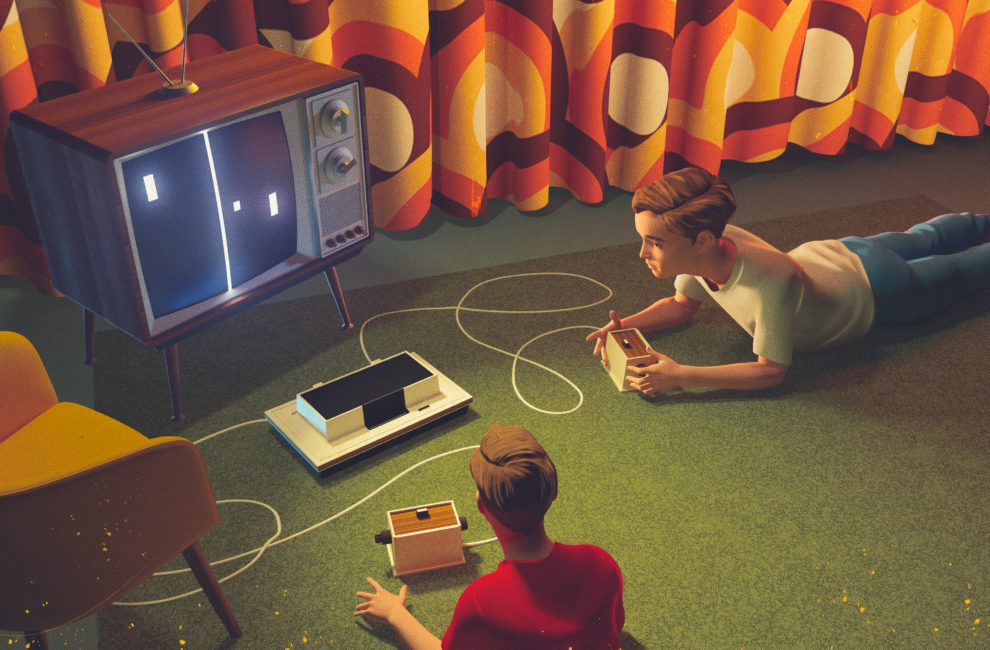
Illustration by Daniel Downey
How The World’s First Home Gaming System Was Made In Indiana

Inventor Ralph BaerPhotos courtesy the Ralph H. Baer Trust
On July 17, 1969, German-born Ralph Baer found himself standing beside a 19-inch TV at the front of the Magnavox corporate boardroom in Fort Wayne holding a putter, a plastic rifle, and a mysterious box wrapped in brown wood-grain vinyl tape. Baer was an engineer from New Hampshire, and he had just finished a demonstration of his latest invention, a presentation that had previously been rejected by several companies, including Magnavox. Still, Baer persisted in his belief that his machine would change the way people thought about their televisions. To his mind, it was all on the screen next to him: one white vertical line bisecting the black field and three white dots. Two dots, one on either side of the line, represented pingpong paddles zipping up and down to “hit” the third dot (the ball) back and forth. It was essentially the world’s first video game. But once again, Baer’s audience seemed underwhelmed.
As Baer looked out at the firing squad of suited Magnavox executives seated around the long, dark conference table, all he saw were glum faces.
Except for one.
That lone enthusiastic smile belonged to Gerry Martin, whose opinion was the only one that mattered. The vice president and general manager for console products, Martin had the conviction of a businessman who saw dollar signs: “We’re going with this.”
Baer’s so-called “Brown Box” was an early prototype of what would come to be known as the Magnavox Odyssey, the first-ever commercial home video-game console. Those four simple words not only instantly lifted the gloom in the room, not to mention eventually fulfilled Baer’s dream of transforming the TV industry—but Martin’s decision in that Indiana boardroom would go on to fundamentally alter everyday life for generations to come.
Over the ensuing months, Baer and technician Bill Harrison would make frequent trips to Fort Wayne to help develop the Odyssey, a machine that, upon its release in mid-September 1972, would enable kids and adults alike to play computerized simulations of volleyball, hockey, target shooting (hence the rifle), golf (the real putter), and, most famously, pingpong in their own living rooms, basements, and bedrooms. More than inventing the idea of a modern video game, Baer was about to introduce the world to the concept of interactivity, years before the buzzword was coined. “When this thing was being pitched, there were only three broadcast networks,” says Alexander Smith, video-game historian and author of 2019’s They Create Worlds: The Story of the People and Companies That Shaped the Video Game Industry. “All you could do is sit back and watch the nightly news or Andy Griffith or whatever these networks deemed worthy of your attention. Baer saw the TV in the corner of his living room and thought there was so much more we could do with this.”
Fifty years after the Odyssey went on sale for $99.95, the practice of playing on our screens has grown into a $300 billion global industry. Today, more than 3 billion people play video games. But Baer and his team of engineers were the first, and it all started in that room of unimpressed Indiana executives half a century ago.

Baer fled Germany as a young man with his family in 1938, then turned around to fight for the U.S., attended school on the GI Bill, and went on to become the father of home video games.
AT FIRST GLANCE, Fort Wayne might seem like an unlikely birthplace for the world of Pac-Man, Mario Bros., Fortnite, and the other fantastic realms in which we all now daily immerse ourselves at home, at work, and on our phones.
After all, Ralph Baer was born half a world away in Germany before fleeing with his Jewish family to New York in 1938, two months before Kristallnacht. He lived most of his life in New Hampshire, and as far as we know, this demonstration was the first and one of the relatively few times he ever set foot in our fine state.
Magnavox is not an iconic Made in Indiana brand in the lineage of Clabber Girl or Eli Lilly and Company. The business started in California in 1917, as a manufacturer of radios, speakers, and phonographs, and it didn’t arrive in Fort Wayne until 1931. It was bought out in 1974 by Philips, a Dutch company that moved the consumer electronics operations to Tennessee less than a decade later.
But history is a finicky piece of software. Look behind the monitor and into the inner workings, and you’ll find lines and lines of precise code. Remove or alter any little character in that programming, even just a little, and the entire on-screen game looks, sounds, and unfolds much differently—or more likely, crashes altogether. And a closer examination of this story finds a role-playing game that is built on a delicate series of preprogrammed world events and dozens of small but significant player decisions.
Here we see a main character whose family pulls him from his home days before the Nazis might have prevented him from ever leaving. He lands in a place and time that had him coming of age at the confluence of two seismic cultural shifts: the emergence of television and the Cold War tech race. That both made him more likely to devote his engineering acumen to experimenting with TV technology and made his adopted homeland more receptive to dedicating manpower and tax dollars to such far-flung technological ideas.
In higher levels of Baer’s journey, he encounters a company that has likewise found itself at a crossroads. In 1969, Magnavox was facing a rapidly changing home entertainment business that would soon see the emergence of cable TV, VCRs, and home stereos. The company was also reeling from the recent loss of its visionary leader, events that had left it more open than usual to the adoption of and investment in new approaches and devices—even a first-of-its-kind TV game with a line and three blips so otherworldly and esoteric that this same company had rejected it just months before. And all of this finally came together in 1972, a time when America was apparently ready (or at least about to be ready) to escape—whether it be from news of Vietnam, Watergate, political assassinations, civil unrest, or Soviet aggression—and turn the knobs on their televisions to a different channel for a new way to play.
If we look at the story through that lens, then the advent of the Odyssey and the birth of the modern video-game industry and culture could only have happened in Indiana. It required the intersection of Baer and Magnavox in a place that was not only dedicated to innovation and manufacturing, but also rooted in the kind of practical thinking necessary to bring this magical box to life. More specifically, it happened in Fort Wayne because of a world-changing innovation from six decades prior that had unmistakably deep roots in Indiana: magnetic copper wiring.
In 1911, a chemist named George Jacobs finally made the breakthrough of a lifetime. For more than a decade, first as an employee of General Electric’s Fort Wayne Works, which produced motors, generators, and transformers, and then on his own, Jacobs had been trying to find a more practical way to insulate the copper and aluminum wiring of the time. Previously, wire had been hand-wrapped in cloth, but that method was costly, bulky, and short-lasting. Jacobs’s innovation was a chemical insulation that was durable and cost-efficient. But most importantly, this new enamel was flexible and would enable thinner wiring to be wound tightly into coils that created electromagnetic fields in smaller electric motors, transformers, inductors, and other components for the consumer machines and electronics that would become commonplace in 20th-century American homes.
Jacobs set up Dudlo Manufacturing, makers of so-called magnet wire (the common name for magnetic copper wire) on Wall Street on Fort Wayne’s south side. It would be the first of several such companies, many started by Jacobs’s disciples, to sprout in Fort Wayne in the coming decades, earning the city the unofficial title of the Magnet Wire Capital of the World.
A reputation like that was bound to make its way across the country, and it eventually came to the attention of the Oakland-based Magnavox. By 1931, the West Coast maker of components for telephones, phonographs, and radios was looking for a more central location with better access to their East Coast markets. What better place than the city that produced two-thirds of the country’s supply of the copper wiring that was essential for virtually all their products?
Seven years after the move to Fort Wayne, Magnavox merged with a small Chicago-based sound-system company started by Frank Freimann. An electrical engineer, Freimann was also a savvy businessman. As new vice president at Magnavox, he convinced his new company to shift from focusing on components and instead put its muscle behind complete consumer products. “Freimann was extremely creative and intelligent and quite a marketer,” says George Collins, curator of the Magnavox Historical Preservation Association in Greeneville, Tennessee. “He ushered in a continued period of innovation and creativity.”
The late 1930s saw Magnavox produce the first hi-fi phonograph and the first portable hi-fi radio. But coming out of World War II, Freimann saw that the future of consumer electronics was clearly in television. In 1947, the company set up a new television engineering and laboratory department, and a year later, they produced their first TV. Within five years, with Freimann having risen to president of the company, Magnavox had bought out a Tennessee cabinet manufacturer (remember, console TVs in the 1950s were essentially huge pieces of immovable furniture) and built an entire plant to produce televisions—and then another, one of the country’s largest, in 1962.
In those post-war days when every “Home of Tomorrow” was packed with newfangled household appliances, Magnavox was a major player in consumer electronics. It was able to call its own shots and maintain its place in the market by employing a fairly common strategy. Instead of shipping its wares to independent retailers, the company moved most of its radios, stereos, record players, and televisions through exclusive, licensed dealers, who sold nothing but Magnavox. This practice ensured corporate control over quality and service—and pricing. But by the late 1960s, this model proved problematic for a couple reasons. First, technological advances in transistors and other components were enabling competitors, including a growing number of Japanese firms such as Sony, to make TVs smaller and cheaper, cutting into Magnavox’s market share while the company was still focused on huge, expensive consoles. Also, the Federal Trade Commission was receiving complaints from dealers that Magnavox might have a little too much control over prices, and by 1967, the FTC had launched a full-blown investigation into the possibility of price-fixing, a charge the commission later confirmed, limiting Magnavox’s ability to dictate prices and further eroding their core business.
In the spring of 1968, amid all this dramatic change, the company’s leader Freimann died suddenly of a heart attack. “He was the one who had moved them into TV so aggressively in the first place,” says Smith, the video-game historian. “Now the company was facing a crisis in leadership, pricing, and technology.”
All of that to say that, by 1969, Magnavox was looking outside of the bulky wooden TV boxes for a new idea to help the company stay in the game.
IF POST-WAR America was truly the age of television, as Freimann believed, then Ralph Baer was the quintessential man for the time.
After serving his new homeland to help defeat the fascists that had run him and his family out of their old one, Baer was one of millions of veterans to go to college on the GI Bill. But he might have been the only one to get a degree in TV—a Bachelor of Science in television engineering from the American Television Institute of Technology in Chicago in 1948. He would claim it was the first such degree given in the U.S. He was 26.
While he may or may not have actually been the first to hold that diploma, Baer was almost certainly ahead of his time in imagining other uses for the technology. One of his first jobs was building projection TVs for Loral Electronics Corp. in the Bronx in 1950. “The TV-engineer lurking ‘unused’ inside of me pondered about ways of using a TV set for something other than watching a standard broadcast,” Baer later wrote in his book, Videogames: In the Beginning (2005). “Some of the test equipment I used during this development job allowed me to create lines and checkerboard patterns on the screen. I thought that it wouldn’t take much to make similar circuitry into a game. [But my boss’s] answer was predictable. ‘Forget it. Just build the damn TV set; you’re behind schedule as it is.’”
Of course, claiming in your biography that you had a vague notion of using TV circuitry to make a game 55 years after the fact doesn’t make you the inventor of video games. And Baer doesn’t make that assertion. He acknowledges in the book that as early as the late 1940s, DuMont Laboratories had patented a “cathode-ray tube amusement device” that allowed players to aim an electromagnetic beam at plastic targets. In 1958, an atomic energy lab on Long Island devised a two-dot tennis game (Tennis for Two) on an oscilloscope as a novel way to attract attendees to their otherwise mundane booth at a trade show. Four years later, an MIT student created Spacewar!, a rudimentary shooter game that required a $60,000 supercomputer to play. “As long as there have been machines, people have played games on them,” says Mark Baer, Ralph’s son. “But Ralph didn’t even know about those things. He was a TV guy. His genius was to take the most common consumer electronic item in the world at the time and turn it from a one-way ‘idiot box’ into an interactive platform.”
Baer never stopped viewing the world through that tube, even when Loral transitioned into being a defense contractor developing technology for the U.S. government in the 1950s. Baer writes that he followed along on this departure from consumer electronics because he wanted to keep his job. But what might seem like a detour on his path to revolutionizing home electronics was actually a key leg of the journey. First, many of the military training devices and programs that Baer found himself working on—first for Loral and then for Sanders Associates in Nashua, New Hampshire—also seemed to him to have potential for entertainment purposes. Perhaps more importantly, this was at a time when the government was essentially writing blank checks to contractors to chase just about any harebrained concept if it could be used in the name of national defense or prestige.
In April 1957, a year after Baer moved to Sanders, the Soviet Union launched Sputnik 1, the first artificial satellite to orbit Earth. This officially kickstarted the Space Race, which transformed the Cold War into a battle of technological supremacy. “Sputnik scared the U.S. [into thinking] that we were losing the Cold War in terms of technology,” says Smith. “It was a really weird and singular time where government research and the military industrial complex contributed so much to technological advancement. Eventually, we would win the Space Race and there would come requirements that government money could only go towards specific, tangible projects, and research on computers would shift into the corporate world. [But during this time], a government contractor could just take Defense [Department] money and do whatever it wanted.”
And before that window closed, in 1966, Baer was able to pull two engineers out of a $10 million military project he was overseeing without anyone at Sanders noticing (or at least caring) and let the employees tinker with an idea he had been harboring for nearly two decades—an invention whose time, he felt, had finally come.

The Odyssey prototype eventually got a flashy makeover in clean white with black trim, but at the expense of both sound and color.
BAER WROTE THAT the epiphany came to him at a New York bus terminal on September 1, 1966. He was sitting on the cement steps outside, waiting for a coworker to arrive, and scribbling notes on a pad, when he had a eureka moment. “The concept of playing video games on an ordinary TV set had bubbled up once again from my subconscious,” he wrote, “and I got that exciting feeling of ‘being on to something.’”
Within six months, Baer’s tiny “TV Game” experimental lab, or skunkworks, at Sanders was moving forward from his detailed handwritten schematics. And after several stops and restarts, by January 1968, Sanders and the engineers had landed on the seventh prototype, the aforementioned Brown Box. The console connected to the television through the VHF antenna screws on the back of the cabinet, ran on six C-cell batteries, and was operated primarily by two hand controllers, or paddles, that featured three knobs each. Additional accessories initially included the light gun and a golf ball mounted at the end of a vertical joystick, teed up so that it could be activated by the tap of an actual putter. The machine came with cards, each containing a unique pattern of dots, that could be inserted into the console between its two rows of switches, triggering a different game—the predecessor of modern-day game cartridges and discs. There were sound effects and even color, if you had a color TV. And to compensate for the primitive three-dot graphics, the team devised plastic overlays that could adhere to the screen and provide more realistic representations of soccer goals, checkerboards, and tennis nets.
After a year of tweaking, the team believed the Brown Box was ready to demonstrate. And because its components were essentially the same as that of a television, they targeted American TV manufacturers. Over the first six months of 1969, half a dozen companies visited Sanders or invited Baer and his team to their headquarters to see the game. RCA, Sylvania, GE, Motorola, and, yes, Magnavox all looked on, gave varying degrees of positive feedback, but ultimately said “no thank you.”
What changed at Magnavox between their initial rejection and that fateful July day in the Fort Wayne boardroom? The job of Bill Enders. He was a marketing man at RCA, one of the first execs to lay eyes on the Brown Box when that company visited Sanders in January 1969. Enders had been impressed by the demonstration, but unable to sway his RCA bosses. Months later, Enders left RCA to become VP of marketing at Magnavox, where he had better luck sharing his enthusiasm for Baer’s invention with Gerry Martin.
Martin’s affirmation launched production of the Odyssey, which Magnavox licensed from Sanders, with Baer staying on to consult. The Brown Box was given a makeover in clean white with black trim. The controllers went down to two knobs and a button, the golf joystick was jettisoned, and the light gun was sold separately. Along with plastic overlays, the console was packaged with playing cards, paper money, and dice to complement the 12 game cards. But to reduce costs, the games lost sound and color in favor of silent black and white.

In September 1972, the Odyssey was released just in time for Christmas. The game sold 69,000 units, outpacing initial projections, but unfortunately falling short of the 100,000 Magnavox manufactured. Fairly or unfairly, the game was branded a failure, a tag the Odyssey would never outlive. In 1975, after only selling 350,000 units worldwide, the Odyssey was discontinued.
The reason for the Odyssey’s abrupt demise is up for debate. Baer believed it was too expensive. The retail price of the system was $99.95, equivalent to about $650 in 2022. (Compare that to the uber-popular Nintendo Switch, which sells for about $300 today.)
Collins, the Magnavox historian, thinks the company’s approach to marketing was a hindrance, particularly their model of end-to-end control. “They were a company that didn’t want anybody messing with their products,” he says. “They produced the electronics, shipped them in their own trucks with their own drivers directly to the dealer. They refused to put a product like that in a big-box retailer, which were coming along in the 1970s.”
Odyssey was only available from Magnavox dealers, which might have unintentionally—or in the case of certain dealers, perhaps intentionally—led to public perception that the gaming system would only work with a Magnavox TV. But more than anything, video-game historian Smith posits that the Odyssey was probably just a little ahead of its time, literally and figuratively. “Electronics weren’t quite cheap yet,” he says. “The integrated circuit existed in 1972, but it was still too expensive. This system still used transistors—not chips.
“And it’s easy to look back on the Odyssey and say ‘That was it! That was the beginning of video games,’” Smith continues. “But what was it at the time? There was nothing else like it.”
MARK BAER LIKES to brag that, because he was his father’s primary test subject for all inventions, he was the first kid to ever play video games at home. He was the first child to realize the anticipation as his father crouched behind the family TV and carefully screwed in the adapter. He then eagerly turned the television knob to the right channel, plopped down crisscross applesauce on the living room carpet, and inserted that brand-new game card into the Odyssey. Then he turned the game on and watched in wonder as the movements of his fingers controlled the action on the bright screen in front of him. And his world was forever changed.
Mark Baer and his brother may have been the first children to have their imaginations swept into a video game, though they were not the last. (Mark likely holds another distinction: the first person to lie about beating his sibling at every game in the box.) While Odyssey’s commercial success is debatable, there is little question about the console’s legacy. In fact, the matter has been adjudicated.
Later in 1972, Nolan Bushnell released an arcade game called Pong, the first offering from his new company called Atari. The game was a smash and helped launch Atari as the arcade and eventually home video-gaming juggernaut of the 1970s. Two years later, Baer convinced Magnavox to sue Bushnell and other Pong copycats for copyright infringement. In 1977, a judge ruled in Magnavox’s favor, citing that Baer’s patent for the Odyssey was the “pioneering patent of the video-game art.”
By then it mattered little, at least for the Odyssey. On the strength of its Atari Video Computer System (VCS, later to be known as the Atari 2600), and a superior lineup of games, including Space Invaders, Bushnell’s company had cornered the home video-game market.
Outside of the courtroom, Magnavox put up very little fight. They sold to Philips in 1974, eventually moving much of the consumer electronics division to Tennessee. With little to no input from Baer, they put out upgrades including the Odyssey 100, Odyssey 200, and finally the Odyssey 2. But by the late 1970s, Baer writes that it was clear to him that the company wasn’t willing to spend the money to go up against Atari. Philips sold what was left of Magnavox in Fort Wayne, the defense electronics division, to Raytheon in 1995. Today all that remains of Magnavox’s presence in the Indiana city are the renamed buildings and the name of the access road Magnavox Way.
Baer would move on, too. He eventually left video games to focus on other inventions, mainly toys, including the wildly popular Simon game for Milton Bradley. Despite his efforts to uphold his intellectual property at trial, Baer didn’t make much of a fuss about public perception, even as Pong became shorthand for the dawn of video games. He turned to the next project, the next invention, the next idea. But as he grew older and started looking back, he had something of a change of heart. In 1998, he reached out to Leonard Herman to help locate a copy of Herman’s seminal history, Phoenix: The Fall & Rise of Videogames. “When I saw him at gaming shows, Ralph was always there in a suit while everyone else was in jeans,” says Herman. “He was an old-school businessman. But later on, it started to bother him that he wasn’t getting the recognition he deserved. You’d open up the encyclopedia and look up who invented video games and it would say ‘Nolan Bushnell.’”
Herman wrote a pivotal feature about Baer in the December 2000 issue of Electronic Gaming Monthly, a relationship which eventually led to Herman publishing Baer’s book. In 2004, Baer donated his prototypes, including the Brown Box, to the Smithsonian Institution Two years later, President George W. Bush awarded Baer the National Medal of Technology in honor of his “groundbreaking and pioneering creation, development, and commercialization of interactive video games.” And in 2010, he was inducted into the National Inventors Hall of Fame.
When Baer died in 2014, at the age of 92, his New York Times obituary referred to him as the man who “turned television sets into electronic fantasy lands by inventing and patenting the first home videogame system.”
Even that comprehensive obit doesn’t include a single mention of the place where this revolution started. Neither do the introductions and speeches given at the hall of fame inductions, industry awards, and medal ceremonies contain a single utterance of the city or state where Baer’s signature invention was made real. And it’s not on the wall placard explaining the Brown Box’s exhibit at the Smithsonian.
But in that corner of the Smithsonian’s National Museum of American History, beside the glass case containing the Brown Box, there is a mock-up of Baer’s New Hampshire workshop. On the shelves are books and tools and electrical components and even some of his completed projects. Among the artifacts is a complete, original Magnavox Odyssey game console. And if you were to reach through the glass and turn the main box over, you’d likely see the same sticker that was on each of the 100,000 original units made. That sticker lists the model number and serial number above the printed line:
THE MAGNAVOX COMPANY
– FORT WAYNE, INDIANA 46803.





